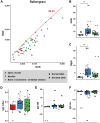Permeability of the blood-CSF barrier in MOGAD: clinical correlation based on the 2023 diagnostic criteria
- PMID: 40202403
- PMCID: PMC11983569
- DOI: 10.1080/07853890.2025.2488181
Permeability of the blood-CSF barrier in MOGAD: clinical correlation based on the 2023 diagnostic criteria
Abstract
Background: The pathogenesis of myelin oligodendrocyte glycoprotein antibody-associated disease (MOGAD) is associated with damage to the blood-cerebrospinal fluid (CSF) barrier (BCB), but a specific correlation remains unclear. We used the newly proposed diagnostic criteria in 2023 with the aim to evaluate the permeability of the BCB in MOGAD.
Methods: We retrospectively analyzed data from 48 eligible patients with MOGAD. Serum and CSF samples were collected simultaneously prior to initiation of immunotherapies at admission. Elevated CSF/serum albumin quotient (QAlb) and indicators of intrathecal immunoglobulin G (IgG) synthesis were calculated as indicators of BCB damage. The relationship between the parameters and clinical features, disease severity, and prognosis were analyzed.
Results: Elevated QAlb levels were detected in 50% of patients, but only a small proportion of patients met the corresponding classifications of intrathecal IgG synthesis, namely IgG index >0.7 (10.4%), IgG synthesis rate >10 (6.2%), and local IgG synthesis rate >0 (8.1%). Elevated QAlb was significantly more common in patients with myelitis than in those with optic neuritis (p = 0.049). It was identified as an independent predictor of moderate-severe disease at admission (modified Rankin Scale [mRS]/Expanded Disability Status Scale [EDSS] ≥ 4). Moreover, elevated QAlb emerged as an independent risk factor for a poor long-term prognosis (mRS/EDSS ≥3 at the last follow-up).
Conclusions: BCB damage was common in MOGAD. Elevated QAlb could serve as a biomarker for evaluating disease severity at admission and predicting long-term prognosis.
Keywords: Blood-cerebrospinal fluid barrier; albumin quotient; disease severity; myelin oligodendrocyte glycoprotein antibody-associated disease; prognosis.
Conflict of interest statement
No potential conflict of interest was reported by the author(s).
Figures




References
-
- Lopez JA, Denkova M, Ramanathan S, et al. . Pathogenesis of autoimmune demyelination: from multiple sclerosis to neuromyelitis optica spectrum disorders and myelin oligodendrocyte glycoprotein antibody-associated disease. Clin Transl Immunol. 2021;10(7):e1316. doi: 10.1002/cti2.1316. - DOI - PMC - PubMed
MeSH terms
Substances
LinkOut - more resources
Full Text Sources
Other Literature Sources
Miscellaneous
